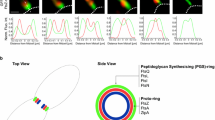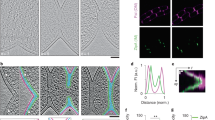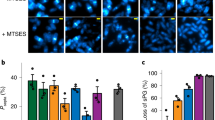Abstract
Bacterial cells need to divide. This process requires more than 30 different proteins, which gather at the division site. It is widely assumed that these proteins assemble into a macromolecular complex (the divisome), but capturing the molecular layout of this complex has proven elusive. Super-resolution microscopy can provide spatial information, down to a few tens of nanometers, about how the division proteins assemble into complexes and how their activities are co-ordinated. Herein we provide insight into recent work from our laboratories, where we used super-resolution gSTED nanoscopy to explore the molecular organization of FtsZ, FtsI and FtsN. The resulting images show that all three proteins form discrete densities organised in patchy pseudo-rings at the division site. Significantly, two-colour imaging highlighted a radial separation between FtsZ and FtsN, indicating that there is more than one type of macromolecular complex operating during division. These data provide a first glimpse into the spatial organisation of PG-synthesising enzymes during division in Gram-negative bacteria.
Similar content being viewed by others
Avoid common mistakes on your manuscript.
Introduction
Cell division in bacteria requires more than 30 different proteins (de Boer 2010). These proteins act in a co-ordinated manner to bring about chromosome segregation, constriction and peptidoglycan (PG) remodelling. How the biochemical activities of these proteins are co-ordinated remains an unsolved mystery. In large part, this can be attributed to the fact that we do not fully understand how division proteins interact in time and space. Structural information on the organisation of proteins at the division site has therefore been a long-standing, yet elusive goal of the cell division community. Unfortunately, owing to the transient nature of this protein assembly little progress has been made by traditional biochemical and structural approaches. However super-resolution fluorescence imaging has emerged as a powerful method for gaining structural insight into the division machinery (Holden 2018). It reveals information about the spatial organisation of proteins in vivo, and to some extent, their dynamics and interacting partners (if two proteins are imaged simultaneously).
A number of studies have utilised super-resolution fluorescence imaging to determine the spatial organisation FtsZ at midcell. FtsZ is considered a key player in division as it is the first protein to arrive at the division site and acts as a recruitment base for other proteins, such as those required for peptidoglycan (PG) remodelling. At the division site it forms proto-filaments that are anchored to the membrane by FtsA and ZipA, and once membrane anchored, these filaments can exert a constrictive force (Osawa et al. 2008, 2009). Initial super-resolution imaging revealed that FtsZ, FtsA and ZipA form patchy rings (or toroids) at the division site (reviewed in Haeusser and Margolin 2016; Holden 2018). Structured illumination microscopy (SIM) imaging suggests that the patchy rings formed by FtsZ, FtsA and ZipA constrict simultaneously, but that proteins involved in PG remodelling are not in the patchy rings (Söderström and Daley 2016; Söderström et al. 2016). However, only a limited amount of information can be gathered from this type of super-resolution imaging, as the resolving power of SIM does not generally exceed 120 nm.
Bisson-Filho et al. (2017) have developed an approach to trap and image Bacillus subtilis cells in a ‘standing’ (i.e., vertical) position using agarose pads with arrays of micron sized holes. Using this simple change of imaging perspective, it was possible to image proteins around the division site without the need for 3D image reconstruction. In a recent study we used agarose pads to trap E. coli cells and image division proteins using time-gated stimulated emission depletion (gSTED) nanoscopy, which has a resolution well below 60 nm (Söderström et al. 2018). When we imaged the native FtsZ and an FtsZ–mNeonGreen fusion, we observed discrete densities, that were distributed as a pseudo-ring around the division site (Fig. 1a) (Söderström et al. 2018). The dimensions (and sometimes the orientation) of the densities varied, but the images suggest that they were on average ~ 110 nm long and ~ 70 to 80 nm thick and covered approximately 65% of the division site.
Super-resolution gSTED images of divisome proteins. a FtsZ–mNeonGreen (mNG). Average density dimensions; length = 109 nm, thickness = 80 nm. b mCitrine (mCit)-FtsN. Average density dimensions; length = 106 nm, thickness = 101 nm. c mCitrine (mCit)-FtsI. Average density dimensions; length = 96 nm, thickness = 77 nm. d FtsZ–mNGreen and mStrawberry–FtsN. All images were obtained by time-gated stimulated emission depletion (gSTED) nanoscopy of E. coli cells immobilised in a vertical position using micron holes produced in agarose pads. Scale bars 500 nm. Data on FtsZ and FtsN have been published previously (Söderström et al. 2018) and are reprinted with permission from Wiley and sons. mCitrine–FtsI was expressed in strain MG1655 from the pRha67 plasmid using 2 mM rhamnose. Technical details on micron hole preparation and imaging are presented in (Söderström et al. 2018)
The FtsZ densities are known to be dynamic, ‘treadmilling’ around the division site (Bisson-Filho et al. 2017; Yang et al. 2017). In doing so they govern the localisation of PG remodelling enzymes, thus coupling FtsZ constriction to PG remodelling. We were further motivated to understand how PG remodelling proteins are spatially organised at the division site, as we believed it would give clarity into the coupling between FtsZ and the PG remodelling enzymes. Initially we focused our attention towards the FtsN protein, an allosteric activator of PG remodelling proteins that initiates envelope constriction (Weiss 2015). In our experiments, E. coli cells were vertically immobilised and gSTED nanoscopy was again used to image the native FtsN, as well as an mCitrine–FtsN fusion (Söderström et al. 2018). The resulting images initially resembled those of FtsZ; they indicated that FtsN formed a pseudo-ring with discrete densities that were distributed around the division site. The densities were on average 110 nm in length and 100 nm in thickness, and they were also dynamic. However, in contrast to FtsZ, the FtsN densities covered a larger average percentage of the pseudo-ring, approximately 80% (Fig. 1b). Although not presented in the original paper we have also probed the distribution of the PG transpeptidase FtsI (also as an mCitrine fusion). Again, we observed a pseudo-ring with dynamic densities that were distributed around the division site. The densities were on average 96 nm in length, 77 nm in thickness and covered roughly 75% of the septal ring (Fig. 1c).
What do the densities seen by super-resolution microscopy represent? The dimensions of the densities for FtsZ, FtsI and FtsN are consistent with large, discrete macromolecular complexes. This observation is supported by protein: protein interaction data, which indicate that FtsZ, FtsI and FtsN physically interact with a number of other divisome proteins (Alexeeva et al. 2010; Buddelmeijer and Beckwith 2004; Di Lallo et al. 2003; Fraipont et al. 2011; Karimova et al. 2005; Müller et al. 2007; Pazos et al. 2013). It has been assumed that all division proteins are assembled into a single macromolecular complex, which is referred to as the divisome. But intriguingly, dual-colour gSTED images revealed that the densities of FtsZ and FtsN did not overlap at the division site. The spatial separation was most obvious as the cells started to constrict, as the FtsZ densities formed a pseudo-ring ‘inside’ that of the FtsN pseudo-ring (Fig. 1d) (Söderström et al. 2016, 2018). Although it has not yet been explicitly resolved whether FtsI co-localises with FtsN during division, super-resolution SIM data do indicate that the FtsI and FtsN pseudo-rings constrict simultaneously (Söderström and Daley 2016; Söderström et al. 2016).
As always, new data generates new insight, but also more unanswered questions. The latest super-resolution fluorescence images of FtsZ and the PG remodelling proteins FtsI and FtsN indicate that all exist in large dynamic macromolecular complexes. These complexes are spatially separated when visualised by super-resolution microscopy. This latter observation can be partially reconciled by bacterial two-hybrid data, which indicates that FtsZ largely interacts with proteins that arrive early at the division site, such as FtsA, ZipA, ZapA, ZapC, ZapD and FtsE. Whilst FtsI and FtsN largely interact with proteins that arrive late to the division site, such as FtsQ, FtsW, Pbp1b and each other. However, there are additional bacterial two-hybrid interactions that are hard to reconcile with the super-resolution images; for example, FtsZ/FtsI/FtsN all interact with ZapA, and FtsZ/FtsN both interact with FtsA. In the end, detailed knowledge of the composition of the complexes observed by super-resolution microscopy would provide important understanding of the functional units that are operating at the division site. This information is essential for re-interpreting old data, as well as designing reconstitution, biochemical and structural experiments that will ultimately reveal the molecular mechanisms that bring about cell division in Gram-negative bacteria.
References
Alexeeva S, Gadella TWJ, Verheul J, Verhoeven GS, den Blaauwen T (2010) Direct interactions of early and late assembling division proteins in Escherichia coli cells resolved by FRET. Mol Microbiol 77:384–398
Bisson-Filho AW, Hsu Y-P, Squyres GR, Kuru E, Wu F, Jukes C, Sun Y, Dekker C, Holden S, VanNieuwenhze MS et al (2017) Treadmilling by FtsZ filaments drives peptidoglycan synthesis and bacterial cell division. Science 355:739–743
Buddelmeijer N, Beckwith J (2004) A complex of the Escherichia coli cell division proteins FtsL, FtsB and FtsQ forms independently of its localization to the septal region. Mol Microbiol 52:1315–1327
de Boer PAJ (2010) Advances in understanding E. coli cell fission. Curr Opin Microbiol 13:730–737
Di Lallo G, Fagioli M, Barionovi D, Ghelardini P, Paolozzi L (2003) Use of a two-hybrid assay to study the assembly of a complex multicomponent protein machinery: bacterial septosome differentiation. Microbiol Read Engl 149:3353–3359
Fraipont C, Alexeeva S, Wolf B, van der Ploeg R, Schloesser M, den Blaauwen T, Nguyen-Distèche M (2011) The integral membrane FtsW protein and peptidoglycan synthase PBP3 form a subcomplex in Escherichia coli. Microbiol Read Engl 157:251–259
Haeusser DP, Margolin W (2016) Splitsville: structural and functional insights into the dynamic bacterial Z ring. Nat Rev Microbiol 14:305–319
Holden S (2018) Probing the mechanistic principles of bacterial cell division with super-resolution microscopy. Curr Opin Microbiol 43:84–91
Karimova G, Dautin N, Ladant D (2005) Interaction network among Escherichia coli membrane proteins involved in cell division as revealed by bacterial two-hybrid analysis. J Bacteriol 187:2233–2243
Müller P, Ewers C, Bertsche U, Anstett M, Kallis T, Breukink E, Fraipont C, Terrak M, Nguyen-Distèche M, Vollmer W (2007) The essential cell division protein FtsN interacts with the murein (peptidoglycan) synthase PBP1B in Escherichia coli. J Biol Chem 282:36394–36402
Osawa M, Anderson DE, Erickson HP (2008) Reconstitution of contractile FtsZ rings in liposomes. Science 320:792–794
Osawa M, Anderson DE, Erickson HP (2009) Curved FtsZ protofilaments generate bending forces on liposome membranes. EMBO J 28:3476–3484
Pazos M, Natale P, Margolin W, Vicente M (2013) Interactions among the early Escherichia coli divisome proteins revealed by bimolecular fluorescence complementation. Environ Microbiol 15:3282–3291
Söderström B, Daley DO (2016) The bacterial divisome: more than a ring? Curr Genet 63(2):161–164
Söderström B, Mirzadeh K, Toddo S, von Heijne G, Skoglund U, Daley DO (2016) Coordinated disassembly of the divisome complex in Escherichia coli. Mol Microbiol 101:425–438
Söderström B, Chan H, Shilling PJ, Skoglund U, Daley DO (2018) Spatial separation of FtsZ and FtsN during cell division. Mol Microbiol 107:387–401
Weiss DS (2015) Last but not least: new insights into how FtsN triggers constriction during Escherichia coli cell division. Mol Microbiol 95:903–909
Yang X, Lyu Z, Miguel A, McQuillen R, Huang KC, Xiao J (2017) GTPase activity-coupled treadmilling of the bacterial tubulin FtsZ organizes septal cell wall synthesis. Science 355:744–747
Acknowledgements
Work in the SCB unit is supported by core subsidy funding from Okinawa Institute of Science and Technology Graduate University. BS acknowledges support from JSPS KAKENHI through a Grant-in-Aid for Young Scientists (number JP17K15694). DOD acknowledges support from Carl Trygger Stiftelsen and the Swedish Research Council.
Author information
Authors and Affiliations
Corresponding authors
Ethics declarations
Conflict of interest
The authors declare that they have no conflict of interest.
Additional information
Communicated by M. Kupiec.
Rights and permissions
Open Access This article is distributed under the terms of the Creative Commons Attribution 4.0 International License (http://creativecommons.org/licenses/by/4.0/), which permits unrestricted use, distribution, and reproduction in any medium, provided you give appropriate credit to the original author(s) and the source, provide a link to the Creative Commons license, and indicate if changes were made.
About this article
Cite this article
Söderström, B., Chan, H. & Daley, D.O. Super-resolution images of peptidoglycan remodelling enzymes at the division site of Escherichia coli. Curr Genet 65, 99–101 (2019). https://doi.org/10.1007/s00294-018-0869-x
Received:
Revised:
Accepted:
Published:
Issue Date:
DOI: https://doi.org/10.1007/s00294-018-0869-x





